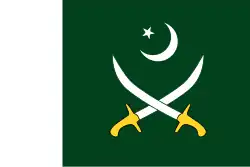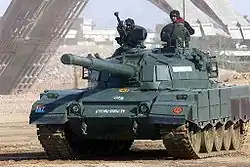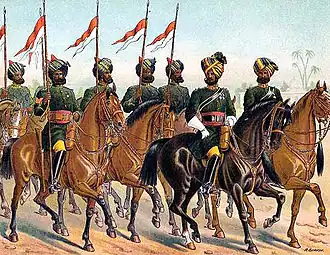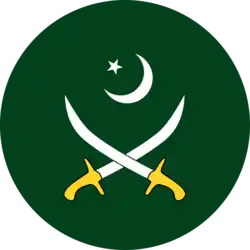Pakistan Army Armoured Corps
| Pakistan Armoured Corps | |
|---|---|
 Badge of the Armored Corps | |
| Active | 1947 |
| Country | |
| Branch | |
| Role | Combat and combined arms administrative and staffing oversight. |
| Size | 52 regiments[1] |
| HQ/Garrison | Nowshera Cantonment, Khyber-Pakhtunkhwa in Pakistan.[2][3] |
| Nickname(s) | AC Men of Steel[4] |
| Color identification | Red and Yellow |
| Anniversaries | 1947 |
| Engagements | Military history of Pakistan |
| Commanders | |
| Director-General | Maj-Gen. Zafar Iqbal Marwat |
| Notable commanders | Lt. Gen. Shah Rafi Alam
General Jehangir Karamat General Shamim Alam Khan Lt-Gen Nadeem Zaki Manj Lt-Gen Hameed Gul Lt-Gen Gul Hassan Khan Maj-Gen. Bilal Omer Khan |
| Insignia | |
| War flag |  |
| Administrative Corps of the Pakistan Army | ||||
|
The Pakistan Army Armoured Corps is a military administrative and combined arms service branch of the Pakistan Army.[3]
Headquartered in Nowshera, Khyber-Pakhtunkhwa in Pakistan, the corps is commanded by its director-general, Major-General Zafar Marwat as of 2023.[2]
Overview
The Pakistan Army's armored corps was commissioned as an administrative corps from one-third of the personnel and assets of the British Indian Army's Indian Armoured Corps– there were six regiments that formed the basis of the Armoured Corps.: 156 [5][6]
During the early years, the British Army officers played a crucial role in running the military operations from the Nowshera Cantonment which remains till this day Armoured Corps' headquarter.: 83 [7] Until 1956, the training and field manuals were based on British Army but later adopted U.S. Army's field manual and training, which is continue to be practiced by armoured corps' training school.[8] The School of Armor and Mechanized Warfare trains cadets and officers to be a part of the Armored Corps at the Nowshera Cantonment.[9] The Armored Corps is commanded by the director-general who is usually at two-star active duty rank, Major-General, working directly under the Chief of the General Staff at the Army GHQ in Rawalpindi.[8]
The Armoured Corps only has an administrative control over its combat strike brigades and such brigade teams are employed in numbers of strike maneuver corps to defend the national borders of Pakistan from the foreign threats.[10][11][12][13]
Until 2001, the armoured corps was focused towards opposing Indian advances in the east but later stationed its interests in western border to prevent foreign threats coming from Afghanistan.[14]
In 2012, the CIA used satellite imagery to estimate that there were 32 armoured regiments in Pakistan Army, including two armoured reconnaissance regiments.[15] Most of these units were operating near the border with India.
Regiments in the Corps
At the time of independence of the country in August 1947, Pakistan Army inherited six armoured regiments from the British Indian Army, as follows:
| Regiment | Nickname | Raised |
|---|---|---|
| President's Bodyguard (Pakistan)[16][17] | PBG | 1773 |
| 13th Lancers[17][18] | The Spearhead Regiment | 1817 |
| Guides Cavalry[17][19] | The Guides | 1846 |
| 11th Cavalry (Frontier Force)[17][20] | PAVO Cavalry | 1849 |
| 5th Horse[17][21] | Probyn's Horse | 1857 |
| 6th Lancers[22][23] | Watson's Horse | 1857 |
| 19th Lancers[17][24] | Tiwana Lancers | 1858 |
| 15th Lancers[17][25] | Baluch Horse | 1955 |
| 12th Cavalry (Frontier Force)[17][26] | Sam Browne's Cavalry | 1955 |
| 4th Cavalry (Pakistan) | The Valiants | 1956 |
| 20th Lancers[17][27] | Haideri | 1956 |
| 22rd Cavalry[17] | Death or Glory | 1962 |
| 23rd Cavalry | 1962 | |
| 24th Cavalry (Frontier Force) | The Chargers | 1962 |
| 25th Cavalry | Men of Steel | 1962 |
| 32nd Cavalry | Conquerers | 1964 |
| 27th Cavalry | Steeds of War | 1965 |
| 30th Cavalry[28] | Bold Till Death | 1966 |
| 31st Cavalry[17] | Sprocketeers | 1966 |
| 34th Lancers | Dragoons | 1999 |
| 26th Cavalry[29]: 601 | The Mustangs | 1968 |
| 28th Cavalry[30] | Chamb Hunters | 1969 |
| 29th Cavalry[17] | Bengal Tigers | 1969 |
| 33rd Cavalry[17][31] | Fortunes with the Bold | 1971 |
| 38th Cavalry[32] | Desert Hawk | 1971 |
| 39th Cavalry[33] | The Vanguards | 1971 |
| 51st Lancers[22] | Silver Eagles | 1971 |
| 52nd Cavalry[34] | Howal Mastan | 1972 |
| 53rd Cavalry[17] | Golden Eagle | 1972 |
| 54th Cavalry | Hizbullah | 1974 |
| 21 Independent Armoured Squadron | 1985 | |
| 55th Cavalry | Adham | 1985 |
| 56th Cavalry | Raad ul Harb | 1985 |
| 57th Cavalry | Allāhu ʾakbar | 1985 |
| 58th Cavalry | Lionhearts | 1985 |
| 40th Horse[35][36] | Scinde Horse | 1987 |
| 41st Horse[17] | Karakash | 1987 |
| 42nd Lancers[17][27] | Punjab Lancers | 1988 |
| 21st Horse[35] | Murtajiz | 1990 |
| 7th Lancers | Zarrar | 1991 |
| 8th Cavalry[37]: 130 | Izz-Ul-Khail | 1991 |
| 9th Horse | The Arabian Horse | 1991 |
| 14th Lancers | Zarb-e-Ghazi | 1993 |
| 16th Horse[38] | Al-Mugheerat | 1993 |
| 18th Horse[38][36] | 1994 | |
| 17th Lancers | 1998 | |
| 37th Cavalry | Ribat-us-Sehra | |
| 35th Cavalry | AL-MUBARIZUN | 2014 |
| 43rd Cavalry | Al-Zarib | 2015 |
| 44th Cavalry | Hell on Wheels | 2016 |
| 45th Horse | Alambardar | |
| 47th Cavalry | ||
| 36th Cavalry |



Equipment
Early days
During World War II, the British Indian Army received low priority for equipment, and the surplus American tanks and vehicles obtained afterward were mostly outdated. The Indian Armoured Corps operated a mix of obsolete Churchills, Shermans, Stuarts, and armoured cars. This same mix was inherited by the Pakistan Armoured Corps (excluding the Churchill tank), which struggled to keep them operational in the difficult years after independence.[39] After the independence, Pakistan got 135 light armoured vehicles consisting of M3 Stuarts, Humber armoured cars and Daimler armoured cars along with some Universal Carriers, 2 AEC armoured command vehicles and 162 Sherman medium tanks from the division of assets.[40]
Current inventory
Armoured Corps regiments are equipped with the following:
- The VT4 is a Chinese third-generation MBT specifically made for export.
- The Al-Khalid main battle tank is a joint Sino-Pakistani production with a 125 mm smoothbore gun.
- The T-80UD is of Ukrainian origin with a 125 mm smoothbore gun.
- The Al-Zarrar is a heavily upgraded version of the Chinese Type 59 tank equipped with a 125mm smoothbore cannon, ERA, and many more modern equipment.
- The T-85III is an upgraded version of the Chinese T-85AP with a 125 mm smoothbore gun.
- The Type 69 tank is a Chinese MBT with a 105 mm gun.
- The Haider main battle tank has been designed by using the design of the Chinese VT4.
See also
- 6th Armoured Division (Pakistan)
- Azad Kashmir Regiment
- Baloch Regiment
- Frontier Force Regiment
- Northern Light Infantry Regiment
- Punjab Regiment
- Sindh Regiment
References
- ^ The armoured regiments are composed of one battalion each.
- ^ a b "Commanders must focus on training of all ranks, says COAS". The News. 12 November 2021. Retrieved 24 January 2022.
- ^ a b "COAS General Bajwa Visited Armored Corps Regimental Centre Nowshera And Installs New Colonel Commandant of Armoured Corps". pakdefense.com. 14 November 2021. Retrieved 24 January 2022.
- ^ "The Men of Steel". The News. 6 September 2015. Retrieved 24 January 2022.
- ^ Roy, Kaushik (17 January 2013). The Army in British India: From Colonial Warfare to Total War 1857 - 1947. A&C Black. ISBN 978-1-4411-7730-8. Retrieved 14 December 2023.
- ^ Riza, Maj Gen Shaukat. (1989). The Pakistan Army 1947-49. Rawalpindi: Services Book Club
- ^ Cheema, Pervaiz I.; Riemer, Manuel (22 August 1990). Pakistan's Defence Policy 1947-58. Springer. ISBN 978-1-349-20942-2. Retrieved 14 December 2023.
- ^ a b Alam, Shah (2012). Pakistan Army: Modernisation, Arms Procurement and Capacity Building. New Delhi, India: Vij Books India Pvt Ltd. p. 116. ISBN 9789381411797. Retrieved 14 December 2023.
- ^ "PAKISTAN ARMY". PAKISTAN ARMY. 2022-04-25. Archived from the original on 2022-04-25. Retrieved 2022-05-04.
- ^ "Armoured Corps". Pakistanarmy.gov.pk. Retrieved 24 January 2022.
- ^ "India escalations". Pakistanarmy.gov.pk. Retrieved 24 January 2022.
- ^ "Pakistan army launches 'major offensive' in North Waziristan". BBC News. 15 June 2014. Retrieved 24 January 2022.
- ^ "Pak's all-out offensive against Taliban kills 177 militants". Deccan Herald. 16 June 2014. Retrieved 24 January 2022.
- ^ "Pakistan Army Armoured Corps makes Military history, unprecedented World Record". Times of Islamabad. 7 January 2019. Retrieved 24 January 2022.
- ^ "Pakistani Armored Regiments (S)" (PDF). CIA.gov. CIA. Retrieved 14 February 2025.
- ^ The President's Body Guard was formed at independence from the Governor General's Bodyguard, which was raised in 1773 under the name of Governor's Troop of Mughals at that time. In 1956 its name was changed to President's Bodyguard from when Pakistan became a republic. It is the senior-most armoured regiment of Pakistan Army.
- ^ a b c d e f g h i j k l m n o p "BADGES – ARMOURED CORPS". pakarmymuseum.com. Archived from the original on 8 November 2017. Retrieved 12 January 2018.
- ^ 13th Lancers is successor to the 1st and 2nd Native Troops of Bombay Cavalry, raised in 1804 and 1816 respectively.
- ^ The Guides Cavalry (Frontier Force) is the successor to the Corps of Guides raised in 1846.
- ^ 11th Cavalry (Frontier Force) is the successor to 1st and 3rd Regiments of Punjab Cavalry, both raised in 1849.
- ^ 5th Horse is the successor to the 1st Sikh Irregular Cavalry (Wales's Horse), and the 2nd Sikh Irregular Cavalry, both raised in 1857.
- ^ a b Tariq, Sardar Muhammad; Raja, Asif Jehangir. "Spirits Rekindled – Joint Staff Pakistan Day Parade - 2015". Hilal: The Pakistan Armed Forces Magazine. Retrieved 9 December 2022.
- ^ 6th Lancers is the successor to The Rohilkhand Horse raised in 1857, and the 4th Sikh Irregular Cavalry raised in 1858.
- ^ 19th Lancers is successor to the 2nd Mahratta Horse (Tiwana Horse) raised in 1858, and Fane's Horse raised in 1860.
- ^ 15th Lancers is successor to the Muttra Horse and 7th Bombay Cavalry, raised in 1857 and 1885 respectively.
- ^ 12th Cavalry (Frontier Force) is the successor to 2nd and 5th Regiments of Punjab Cavalry, both raised in 1849.
- ^ a b 20th Lancers is associated with the Punjab Regiment.
- ^ "The Gazette of Pakistan. Part II. Notifications issued by the Ministry of Defence and the Ministry of Defence Production" (PDF). Government of Pakistan. 9 September 2020. p. 492. Retrieved 12 December 2022.
- ^ "The Gazette of Pakistan. Part II" (PDF). Government of Pakistan. 16 December 2020. Retrieved 12 December 2022.
- ^ "The Gazette of Pakistan. Part II" (PDF). Government of Pakistan. 21 April 2021. p. 108. Retrieved 16 December 2022.
- ^ 33rd Cavalry is the only Pakistani armoured regiment which has five battle honours to its credit post-independence.
- ^ "The Gazette of Pakistan. Part II" (PDF). Government of Pakistan. 1 January 2020. p. 1. Retrieved 16 December 2022.
- ^ "The Gazette of Pakistan. Part II" (PDF). Government of Pakistan. 16 June 2021. p. 243. Retrieved 16 December 2022.
- ^ "The Gazette of Pakistan. Part II" (PDF). Government of Pakistan. 27 January 2021. p. 21. Retrieved 13 December 2022.
- ^ a b "Public Tenders page 2". Public Procurement Regulatory Authority. Archived from the original on 8 December 2022. Retrieved 8 December 2022.
- ^ a b "The Gazette of Pakistan. Part II" (PDF). Government of Pakistan. 3 June 2020. p. 201. Retrieved 16 December 2022.
- ^ "The Gazette of Pakistan. Part II" (PDF). Government of Pakistan. 26 February 2020. Retrieved 12 December 2022.
- ^ a b "Public Tenders page 1". Public Procurement Regulatory Authority. Archived from the original on 8 December 2022. Retrieved 8 December 2022.
- ^ Major-General Syed Ali Hamid (2021). At the Forward Edge of Battle: A History of the Pakistan Armoured Corps 1938-2016. Warwick, England: Helion & Company Limited. p. 58. ISBN 9781914377471.
- ^ Major-General Syed Ali Hamid (2021). At the Forward Edge of Battle: A History of the Pakistan Armoured Corps 1938-2016. Warwick, England: Helion & Company Limited. pp. i–viii, 59. ISBN 9781914377471.
External links
- Pakistan Armoured Corps on www.regiments.org
